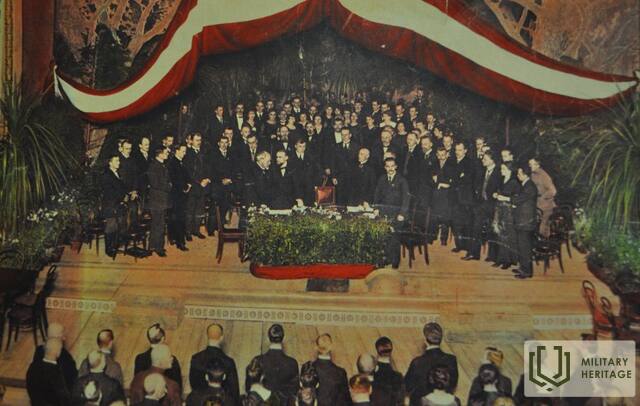Declaration of the Latvian state
I Wars of Independence
The end of World War I on November 11, 1918, gave rise to new nation-states on the ruins of the collapsed German, Russian, and Austro-Hungarian empires. One of them was the Republic of Latvia. On the afternoon of November 18, 1918, the establishment of an independent Latvian state was proclaimed in the modern Latvian National Theater.
The idea of Latvian independence gained wider popularity in the second half of 1917, when the political and economic chaos prevailing in Russia encouraged most of the Latvian political spectrum to lean in favor of the demand for independence. Despite various restrictions and repressions from the German and Bolshevik authorities, the two largest Latvian political organizations - the Democratic Bloc (DB) and the Latvian Provisional National Council (LPNP), continued to popularize the idea of Latvian independence in 1918.
The end of the war provided an opportunity to implement the idea of independence in life. However, the process of proclaiming the Republic of Latvia was not easy. The difficulties of unifying the DB and LPNP delayed the proclamation of Latvia's independence for a whole week. This was hindered by both mutual intrigues and personal ambitions, as well as the different foreign policy orientations of the two organizations (the DB was oriented more towards Germany, while the LPNP was oriented towards the Allied or Entente countries). The founding of the state required the unification of all political forces, and this was achieved on November 17, when the parties agreed on the establishment of the Latvian People's Council (LTP). Consequently, the DB and LPNP ceased their activities, and the members of these organizations continued to work in the LTP and the Provisional Government of Latvia. The Chairman of the Latvian People's Council was Jānis Čakste, a member of the LPNP, and the head of the Provisional Government was an active DB representative Kārlis Ulmanis. On November 17, the LTP also agreed on a common political platform, determining the principles on which the new state would be founded.
The solemn act of proclamation of the Republic of Latvia was decided to be held the next day in the modern Latvian National Theatre, inviting 1,200 guests to the event. The theatre premises were already full well before the big event. The solemn session of the LTP began at 4:30 p.m. 38 LTP members took to the stage to proclaim the Republic of Latvia. The solemn session was opened by the late President of Latvia, Gustavs Zemgals. The joint political platform of the Latvian People's Council was read out, several LTP members and the Chairman of the Provisional Government, K. Ulmanis, made speeches. Long applause followed and the anthem "God, Bless Latvia" was sung three times. The session of proclamation of the Latvian State ended at 5:45 p.m.
The act of proclamation of the state is widely covered in the Latvian press. The inhabitants of Latvia are informed about the founding of the state with a specially prepared printed appeal “To the citizens of Latvia”. Celebrations are held in many places in Riga and Latvia to celebrate this event.
More information sources
1. 100 Events in the History of Latvia. People and Processes 1918-2018. AS “Latvijas Mediji”, 2018.
2. Šiliņš, J. lsm.lv series #LV99plus or Living History publication “What and why should we know about the proclamation of the state of Latvia on November 18, 1918?”, 2020. Available: https://www.lsm.lv/raksts/dzive--stils/vesture/kas-un-kapec-jazina-par-latvijas-valsts-proklamesanu-1918-gada-18-novembri.a300058/ [accessed: 30.03.2021.]
Related timeline
Related stories
March 1917 - an important month in the history of Valmiera and Latvia
In March 1917, more than a year before the proclamation of the state of Latvia, the Vidzeme Provisional Land Council was founded in Valmiera, which adopted a resolution on the autonomy and self-determination rights of Latvia. On the day of the founding of the Council, the red, white and red flag was raised for the first time at the meeting place.
Gennady Kirillovich's story about the creation of the Latvian state border after the restoration of Latvia's independence
G. Kirilovičs' story about the establishment of the Latvian state border after the restoration of Latvia's independence (interview in audio file, in Latvian)





